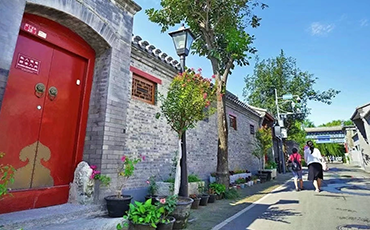


2.Beijing: Urban Renewal Development and Institutional Progress.
2.1 Development History and Challenges
- Four stages in the evolution of urban renewal in Beijing.
Next, let's learn about the characteristics and progress of urban renewal system construction in the capital. Before reform and opening up, urban renewal in Beijing was a period of restoration of production and life and space construction under planned regulation; after reform and opening up, market forces emerged with the emergence of the system of compensated use of land and participated in urban construction on a large scale, which drove the rapid development of the city's economy.Beijing hosted the Summer Olympics in 2008, and cultural and creative spaces such as 798 in Beijing emerged roughly at this time, reflecting the new impact of cultural events have had a new impact on the development of urban renewal.Since 2014, China's new urbanization plan has been introduced, and concepts such as the promotion of the Beijing-Tianjin-Hebei synergistic development have been advanced, as Beijing's urban construction has moved into a phase of fine-grained governance during the period of stockpiling.
- Special Challenges of Beijing's Urban Renewal.
Beijing faces three main constraints in the process of urban renewal: first, the reduction of development, in the context of Beijing's emphasis on “reducing” the size of the land and the size of the buildings, the traditional practice of transforming space and obtaining value-added income by demolishing less and building more, or demolishing the old and building the new, is no longer feasible; second, the evacuation and remediation, which means that Beijing has high quality requirements for the introduction of new functions. This means that Beijing has high quality requirements for introducing new functions, for example, the space needs to be “upgraded” after the relocation of the Zoo Wholesale Market to a scientific research and modern commercial place, and Chongyong Street is also facing various challenges of upgrading its business after the transformation; thirdly, it is an organic renewal, and Beijing emphasizes that it cannot “tear down and build up”, so shantytowns cannot be transformed by tearing down less and building more. Third, organic renewal, Beijing emphasizes not to “demolish and build big”, so shantytown renovation is not covered by the urban renewal policy, and urban renewal is very cautious in the way it is carried out.
At this stage, Beijing's urban renewal is characterized by a “project-driven” approach, in which pilots are used to find a direction and then promoted to form stable rules and systems. Nowadays, Beijing attaches importance to “neighborhood renewal” and the participation of social capital, and actively explores the practices of integrated regional renewal and district renewal; on the other hand, Beijing has also made it clear that it will be driven by responsible planners, and that it will guarantee the fine governance of urban space through the provision of accompanying technical and service support for grass-roots renewal.
- Major Challenges of Beijing's Neighborhood Renewal.
The challenges facing Beijing's urban renewal are multi-faceted. In terms of subject participation, there is a lack of multi-participation mechanisms, cross-departmental communication is difficult, and the responsible planner system needs to be improved. In terms of funding sources, there are insufficient funding sources and a single way, insufficient participation of social capital, and low awareness of residents' contribution. In terms of spatial processing, it is difficult to adjust property rights, complicated to change functions, generally insufficient space, and difficult to support facilities. In terms of project operation and maintenance, lack of operational experience, unclear maintenance subject, and weak mechanism guarantee ...... These are actually typical problems common to many cities.
- Interpretation of the Beijing Urban Renewal Regulations.
Beijing has strengthened the implementation guarantee of urban renewal in recent years through rapid institutional construction. The Beijing Urban Renewal Regulations, as a top-level system, consists of 7 chapters and 59 articles, including the General Provisions, Urban Renewal Planning, Main Body of Urban Renewal, Urban Renewal Implementation, Urban Renewal Guarantees, Supervision and Management, and Supplementary Provisions. If we use the 4S framework to look at the construction of the regulations, there will be many new discoveries.
- Renewal Objects: Classification Guidelines for 5 major categories and 12 renewal objects.
The regulations categorize Beijing's urban renewal targets into 5 major categories and 12 items, of which the 5 categories are: residential, industrial, facilities, public space, and regional comprehensive.
Firstly, the “subject” system is innovative, clarifying the “right-responsibility” relationship of each party. Regulations in the main clear the rights and responsibilities of all parties, the formation of a number of new rules of the main agreement. For example, it actively encourages the “property owner” to initiate autonomous renewal; puts forward the detailed responsibilities of the “neighboring property right holders” and the “implementation subject”; and learns from Shanghai, and clarifies the “implementation unit coordinator subject”. The role of the “implementation unit coordinator” has been clarified, because when a large area is being regenerated, it is not enough for the implementation unit to be the driving force, but it is also necessary to have a coordinator who can coordinate the preparation of plans and even the formulation of policies to help promote the overall regeneration of the area.
Second, the “funding” system innovation, fiscal and financial policy support. In the financial dimension, the government's direct financial support mainly focuses on public welfare projects; in the new economic environment, it also advocates the establishment of an urban renewal fund, the issuance of local government bonds, corporate bonds and other sources of funding. Projects included in the urban renewal program are entitled to administrative fee reductions and exemptions in accordance with the law. Where the conversion of dilapidated and simple buildings is implemented, property rights holders may withdraw their housing provident funds or utilize provident fund loans to pay for the cost of the conversion.
Fourth, “operation and maintenance” system innovation, clear project operation and management process. At the level of operation and maintenance, from the perspective of urban management, due to the lack of clear workflow guidelines for urban renewal projects in the past, many implementation entities cannot find a point of entry and a handle for their work. The regulation proposes that Beijing should form a specific renewal workflow for project planning and preparation, implementation program preparation, joint program review, etc., and issued a series of process operation rules in April-June this year, according to which the joint review and joint approval of the program will be promoted, while also incorporating the industrial and commercial registration and supervision that may be involved in the later projects into the renewal management process.
In the operation of service projects through the standardization of construction services, the most representative is the fire code. Because the existing codes are mainly proposed for new buildings, it is difficult for old buildings to be remodeled to meet the current fire protection requirements. Beijing has introduced new regulations to make it clear that buildings can be given the opportunity to do so after renewal as long as there is an improvement in fire protection over the past.
More detailed can be accessed by:https://mp.weixin.qq.com/s/KlU7O6E-SS7PiUOpYMkqZg
Edited and Translated by Tao Guan